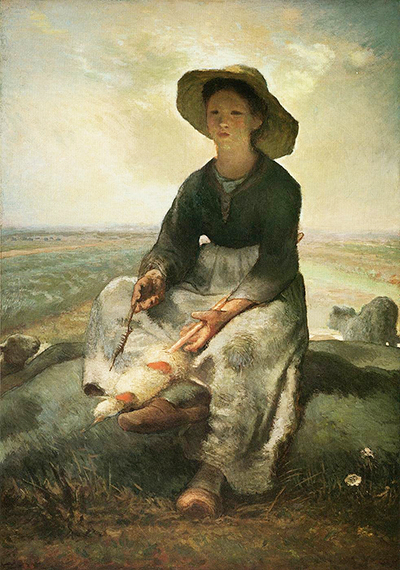The Young Shepherdess, is an 1873 painting by Jean -Francois Millet. This painting depicts a woman in peasant clothing. She is seen turned away but still facing the viewer as she holds something that looks like a plant in one hand and a digging tool in another. This piesce is a good example of how painters reused materials when they were in short supply.
Millet’s first submission of the Jews in Israel was not received well in 1848 at the Paris Salon, which caused the artwork to disappear for a while. Later, scientists from the Museum of Fine Arts in Boston x-rayed it and discovered Millet had painted his captivity scene during the Franco-Prussian war, a time at which materials were scarce.
Other Paintings
Man with Hoe, 1862, is a depiction of the grinding hardship of the constant cycle of peasants. For, instance, in France, before a harvest was gathered, the fieldshad to be cleared and replanted. Before being ploughed, they had to first be cleared of stubble and weed, something that had to be done with a tool known as a hoe. This tool is fatiguing and requires a lot of energy. In this painting, the labourer is seen resting on the hoe while planting from his exertions. For a moment, he pauses to rest. He is seen covered in sweat, his lips appear cracked and dry and is in a pair of rough pants, a vest and clogs. The blank expression on his face signals a man close to the end of his strength.
The Potato Harvest, 1855, depicts a group of poor harvesters. One farmer is seen emptying a basket of potatoes into an empty sack, which is held open by a woman. Besides them is a cart and three sacks filled with the potatoes. Above them is a dark cloud sufficed with sunlight. Behind the couple are two farmers digging potatoes which are being gathered by women. This artwork is a representation of French peasants struggling to survive.
Autumn Landscape with a Flock of Turkeys, 1873, is a Barbizon School oil on canvas artwork. It depicts a hillock with one tree that is almost bare of leaves. The tree is placed far back in the painting, a representation of the end of the season. The painting shows a woman looking after her flock of turkey as they feed. The village is indicated in the background on a lower plane. In the distance is the tower of the neighbouring hamlet of Chailly-en-Biere.
The Angelus, 1859, returns the artist to his childhood memories. Millet focused on how when labouring in the fields his grandmother would not fail to stop and recite the Angelus in honour of the dead souls upon hearing the bell toll. In this painting, is a couple seen standing in a field in a moment of devotion as dusk rolls in.




